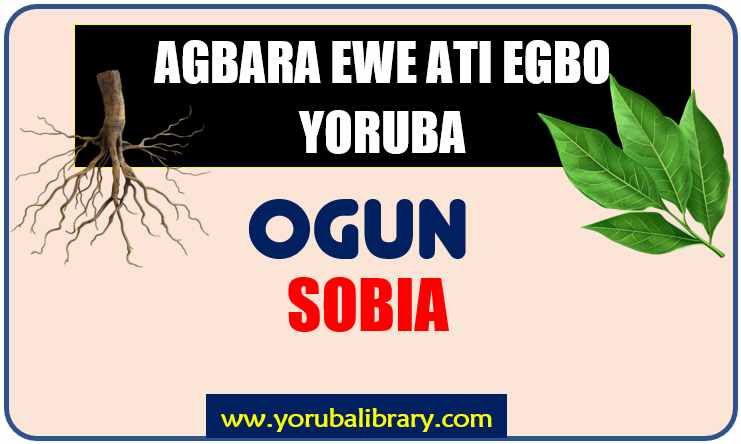
support@yorubalibrary.com
+2348073529208, 07038599574

Among the Yoruba people, Ogun Sobia refers to traditional remedies used to treat Guinea worm infection (Dracunculiasis). This disease, caused by the parasitic Guinea worm (Dracunculus medinensis), was once widespread in rural communities where people relied on stagnant ponds and open water sources. When a person drank contaminated water containing the larvae of the worm, the parasite eventually grew inside the body and emerged through the skin, usually on the legs or feet. Our forefathers observed this condition long before modern science explained it. They noticed the long, threadlike worm painfully emerging from the body and understood it as a severe health burden that weakened movement, disrupted farming, and caused social discomfort. Yoruba traditional healers responded by creating herbal treatments and careful methods of extraction, aiming to ease the pain, prevent infection, and restore the patient’s strength.
Our forefathers observed this condition long before modern science explained it. They noticed the long, threadlike worm painfully emerging from the body and understood it as a severe health burden that weakened movement, disrupted farming, and caused social discomfort. Yoruba traditional healers responded by creating herbal treatments and careful methods of extraction, aiming to ease the pain, prevent infection, and restore the patient’s strength.
While modern medicine has nearly eradicated Guinea worm globally through clean water campaigns, Yoruba trado-medicine remains a valuable cultural record of how forefathers managed the condition using plants and natural practices.
Disclaimer
Yoruba Library and its Team will not be held liable for improper usage or any loss arising from improper use, wrong application, inability to find needed materials, or misinterpretation of this article. This article is provided strictly for guidance and educational purposes.
Symptoms Observed by Our Forefathers
Our forefathers recognized Guinea worm infection by its striking and painful signs:
(1) Burning pain and swelling, usually in the lower limbs.
(2) Blister-like sores forming on the skin, often at the point where the worm would emerge.
(3) Visible movement of a thin, threadlike worm under the skin.
(4) Fever, fatigue, and restlessness due to constant discomfort.
(5) Difficulty in walking, farming, or carrying out daily duties.
How Our Forefathers Treated Guinea Worm in the Past
To deal with Sobia, Yoruba healers used practical methods rooted in herbs and patience:
Herbal Poultice for Pain Relief – Leaves and roots with cooling and soothing properties were applied to the blistered area to reduce burning pain and swelling. Below are some leaf which our forefathers have previously used in treating Sobia (Guinea Worm):
1) Ewe Akerejupon
2) Ewe Odan
3) Ewe Osepotu
4) Ewe Iyeye
5) Obi Edun
6) Ewe Abamoda
7) Ewe Reku-reku
Have you heard of Yoruba Herb Dictionary? This contains names of Yoruba Leaf, Roots, Barks, Characteristics, Properties & Identification with HD Pictures. Order below or download sample here
A-Z HERBS & LEAF DICTIONARY #4KOne Yoruba proverb says "Bí olóde ò kú, òde rè kì í wu Gbégi". Do you know that Gbégi is actually a leaf/plant? Get Yoruba Proverbs on Plants and Herbs, which is a collection of Untold Wisdoms Hidden in Leaf and plants comprising their Life Applications & Moral Teachings. Order below or download sample here
YORUBA PROVERBS ON PLANTS #4KThe Healing Process in Traditional Practice
The Yoruba healing method for Guinea worm was systematic and required patience:
1. Selection of Herbs –
Healers chose herbs that reduced pain, kept the wound clean, and promoted healing.
2. Careful Daily Attention –
Worm removal was never rushed; the healer supervised gradual extraction to avoid complications.
3. Supportive Care –
Patients were encouraged to rest and avoid strenuous work until full healing occurred.
4. Post-Healing Care –
After the worm was fully removed, herbal ointments were applied to restore the skin and prevent scarring.
Differences Between Yoruba and Modern Treatment
• Yoruba Method –
Relied on herbal washes, poultices, and careful extraction by hand, supported by decoctions to strengthen the body.
• Modern Method –
Uses clean water, antiseptics, pain relief, and medical supervision. Prevention through safe drinking water is the main solution today.
• Similar Principle –
Both emphasize careful worm extraction, pain management, and prevention of infection.
Safety First: Important Contraindications and Considerations
• Pregnancy and Lactation – Some herbs used for fever and cleansing may be unsafe during pregnancy or breastfeeding.
• Underlying Conditions – People with weak immune systems or chronic health issues required extra caution and lighter preparations.
• Source Quality – Only herbs from clean, natural sources were considered safe; polluted plants could worsen infection.
• Children and the Elderly – These groups were treated with gentler herbal mixtures to prevent excessive weakness.
Needed Materials (Leaves, Roots, Bark, etc.)
The medicinal approach for this requires careful selection of natural materials traditionally known to our elders. These are combined to ensure potency.
The instruction you will receive is the original account of our forefathers, preserved and tested over time. Many people have used them with testimonies of relief. Just ensure you follow the correct guidelines. Click Unlock Secret below
Application Process
The strength of Yoruba medicine depends on how materials are handled. Proper pounding, boiling, or steeping — done in the right way and at the right time — ensures the remedy remains potent. Click Unlock Secret below
Uses
The prepared remedy must be applied in the correct manner — whether for drinking, steaming, bathing, or chest rubbing — and taken in the right dosage for it to remain effective.
1) Some leaf required special utterances/chants before they can be effective. Where applicable, this will be stated in the PDF
2) The methods of getting the needed items like leaf, bark, roots by yourself is covered in the PDF
3) Saa bi Ologun ti wi, ki o le baa je... (Follow instructions for it to remain potent). You're getting a Real and Original account of our fore fathers.
With Numerous Satisfied Clients...